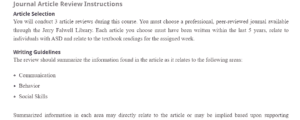High-functioning Autism Spectrum Disorder
According to Duncan et al.’s (2017) study, deficits or shortfalls in daily living skills (DLS) are related to poor adult outcomes, including language skills, employment abilities, and other routine functions, especially for people with high-functioning ASD (autism spectrum disorder). However, there are very minimal or completely no interventions or services in the community targeting DLS deficits among these high-functioning ASD adults (especially adolescents in high school), which can assist them in integrating and transitioning into normal adult life, including employment, independent living, postsecondary education, as well as community participation. This study, therefore, specifically examines how three interventions (Second Edition Age Equivalence Scores, Vineland Adaptive Behavior Scales, and Four-Goal Attainment Scaling Scores) can improve DLS deficit outcomes among high-functioning ASD adults, including communication, behaviour, and social skills. Seven teenagers (aged 14-18) with ASD and their parents were selected and recruited for a twelve-week feasibility pilot study that targeted daily living skills, including money management, laundry, cooking, and morning routine. All the scores were examined at baseline, during follow-up, and at six-month post-treatment.
Are you looking for an original copy of “High-functioning Autism Spectrum Disorder”? Get in touch with us.
Communication
To test the communication and cognitive skills of the participants, the researchers applied the Stanford-Binet Intelligence Scales (5th edition) and the Differential Ability Scales (2nd edition). Specifically, the researchers examined the full-scale IQ, nonverbal, and verbal skills. The Vineland-II method was also used to some extent to examine skills in the communication domain. The research outcomes showed that although the participants had a chronological mean age of 16.7 years at baseline, there was a gain of about 2-2.5 years worth of daily living skills within the twelve-week, including cognitive and communication skills. This advantage was preserved or enhanced at a six-month follow-up.
Social Skills
To measure the maladaptive behaviour of the participants, the researchers adopted the Vineland-II model, which can examine socialization and communication skills as well as capabilities in the DLS domains, including community (such as navigating the community area and financial management), domestic (such as doing laundry and cooking), as well as personal (such as self-care and personal hygiene). The outcomes from baseline to follow-up showed statistically significant progress in the development of the raw scores of the DLS domain (p=0.001, t(6) = 3.880) as well as community subdomain (p=0.005, t(6) = 4.41).
Behaviour
Besides social and communication skills, the Vineland-II technique was also applied by the researchers to examine the maladaptive behaviour of the participants (those with high-functioning ASD). According to Boutot (2016), this tool is significant in measuring a person’s adaptive character profile at a specific period, meaning that it is rarely applied in measuring outcomes in treatment research since it might not be responsive to short-range or immediate changes. In addition, and more comprehensively, DLS Goal-Attainment Scaling (GAS) technique was used to estimate each participant’s progress toward achieving particular goals, which were compared with baseline performances. The paired-sample t-tests for the DLS GAS scores showed statistically noteworthy progress in the average item score of all four sections of the tool from baseline to post-treatment, including Money Management (p<0.001, t(6) = -6.76), laundry (p<0.001, t(6) = -8.84), cooking/kitchen (p<0.001, t(6) = -12.57), and morning routine (p<0.001, t(6) = -12.73).
Conclusion
This study demonstrates that several community interventions can help improve daily living skills among high-functioning teenagers with ASD. For example, Goal Attainment Scaling Scores have improved adolescent functional daily living skills, including money management, laundry, cooking/kitchen, and morning routine. On the other hand, the Vineland-II tool has improved in Vineland’s three domains, personal, domestic, and community.
Similar Post: Students with Communication Disorders
References
Boutot, E. A. (2016). Autism Spectrum Disorders: Foundations, Characteristics, And Effective Strategies. Pearson.
Duncan, A., Ruble, L. A., Meinzen-Derr, J., Thomas, C., & Stark, L. J. (2018). Preliminary Efficacy Of A Daily Living Skills Intervention For Adolescents With A High-Functioning Autism Spectrum Disorder. Autism, 22(8), 983-994.
ORDER A PLAGIARISM-FREE PAPER HERE
We’ll write everything from scratch
Question
Journal Article Review Instructions
Article Selection
You will conduct 3 article reviews during this course. Choosing a professional, peer-reviewed journal from the Jerry Falwell Library would be best. Each article you choose must have been written within the last five years, relate to individuals with ASD and relate to the textbook readings for the assigned week.

High-functioning Autism Spectrum Disorder
Writing Guidelines
The review should summarize the information found in the article as it relates to the following areas:
- Communication
- Behaviour
- Social Skills
Summarized information in each area may directly relate to the article or may be implied based on supporting information from the course text.
Each review must be two pages (excluding title and reference pages) and follow the current APA format (including in-text citations and headings). Each article should include at least two sources (course text and selected article); however, additional references are encouraged. In-text citations should be included for the three specified areas, and references should be provided at the review’s end. The review should include an Introductory and Closing paragraph and a paragraph for each of the three required headings (communication, behaviour, social skills).
- The introductory paragraph should provide a brief overall summary of the article and study conducted.
- The paragraphs for each of the three headings should address information specific from the article regarding the respective heading. Clear links should be made between the article and assigned weekly readings.
- The closing paragraph should include a clear summary of the main points of the article and implications for supporting individuals with ASD.


